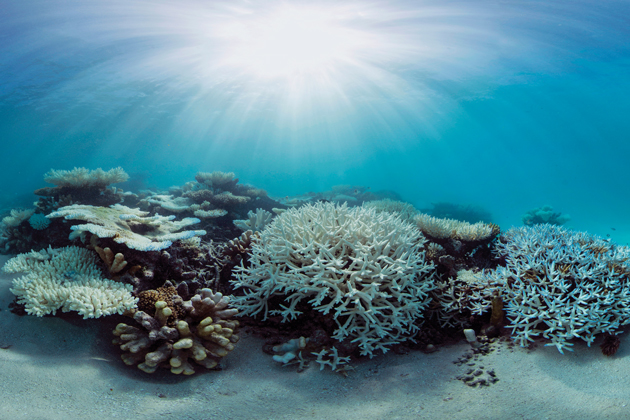White Out: How Climate Change is Killing Earth’s Coral Reefs
While most people think of evolution as something that happens over millennia, it can actually occur much more quickly. That could have major implications for the world’s coral reefs.
In recent years, as sea temperatures continue to rise due to climate change, reefs around the planet have experienced repeated bouts of mass bleaching. Bleaching is a phenomenon where coral polyps stressed by high water temperatures expel algae that live within their tissue, leaving reefs looking as if they’ve been bleached white. These algae provide most of the coral’s nutritional needs and without them, the polyps eventually starve. Recent bleaching has killed more than 50 percent of corals on much of Australia’s Great Barrier Reef, and scientists predict that 90 percent of the world’s reefs could die or become ecosystems populated by drastically different residents before this century ends. And the loss of healthy coral reefs will have far-reaching consequences. Unless they can adapt.
A group of marine biologists from around the world and UT recently published a paper in the journal Nature Climate Change calling for more research into the various ways reef-building corals might be able to acclimatize or adapt to climate change. Possibilities include changes in how corals interact with bacteria and algae, changes in the function of genes that corals can pass from one generation to the next, and more rapid genetic adaptation or changes in genetic traits. One of the paper’s authors, Mikhail “Misha” Matz, associate professor in the Department of Integrative Biology at The University of Texas, places his bets on the latter. Despite the common misconception that genetic adaptation happens slowly and therefore cannot possibly keep up with climate change, he points out that such adaptation does not always require new genetic mutations selected over many generations. It can instead happen through recombining and redistributing existing genetic variation.
“Every individual has slightly different genetic conditions, especially among animals living in slightly different environments,” he says. “Collectively, that creates a huge bank of potential genetic variation.”
Matz, who runs a lab studying how reef-building corals adapt to environmental differences and climate change, is creating models of genetic variation found in natural coral populations and the possible ways they might share and reshuffle that variation.
“Everybody assumes corals need to develop temperature tolerance, and that is probably true,” Matz says. But, he adds, they also need to adapt to factors such as changes in the amount of organic nutrients, water movement, water quality, bacterial load, and disease—all things that have enormous effect on coral reefs.
The scientists’ ultimate goal is identifying specific coral reefs where protection and conservation efforts would make the most difference.

“Prioritization is a main problem with conservation,” Matz explains. “We cannot conserve everything, so we need to put our emphasis somewhere. If we know where the adaptive variants are, we can prioritize how to protect them.”
Research can also direct coral restoration efforts, helping to identify the best locations from which to take species for propagation and, in turn, the best places to transplant them. Coral transplanting is labor-intensive and costly but, done right, it can make a difference. A study recently published in the journal Marine Biology showed that within a week of transplanting new corals to damaged reefs, significantly more fish and a greater diversity of species could be found.
Matz has used his models to predict risk of rapid extinction for specific reefs. His results show that the Great Barrier Reef, especially in the south, remains in good shape, but the future looks grim for the Ningaloo Reef off Western Australia. That is partly because the Ningaloo lacks connection to other reefs in the region and thus has little access to more genetic variation.
The promising potential of coral adaptation through existing genetic variation has an important limitation, though. As certain variations are selected over others, fewer and fewer choices remain. To put it another way, Matz says, the engine of adaptation eventually runs out of fuel. He has played around with the models, searching for a scenario that might allow that fuel to replenish, but in every case, it runs out.
“There is no scenario where corals will be able to adapt indefinitely,” he concludes. “They will hold on for a while, maybe 100 or 200 years, then eventually collapse.”
Currently, the estimated annual value of reef services worldwide tops $2 trillion. Reef-building corals provide shelter, food and habitat for at least a quarter of all marine life worldwide. Reef loss leads to decline in the diversity and abundance of other organisms, making the entire ecosystem more vulnerable to collapse. The structures of hard coral reefs also protect coastlines around the world from storms, waves, and erosion.
“Bottom line, evolution is not slow. Genetic variation and genetic diversity buy us some time,” Matz says. “But ultimately, we need to act on climate change.”


















No comments
Be the first one to leave a comment.